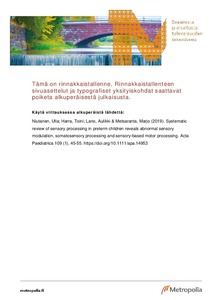Process Mining the Requisition-to-Pay Process: utilising QPR ProcessAnalyzer in Wärtsilä’s Indirect Procurement Department
Haapamäki, Leanne (2025)
Haapamäki, Leanne
2025
All rights reserved. This publication is copyrighted. You may download, display and print it for Your own personal use. Commercial use is prohibited.
Julkaisun pysyvä osoite on
https://urn.fi/URN:NBN:fi:amk-202502142894
https://urn.fi/URN:NBN:fi:amk-202502142894
Tiivistelmä
Process mining is on trend as organisations aim to make their operational processes more efficient. To do so, companies need a clear understanding of current processes. Research shows that people tend to be aware of 40% of a process, and reality is far more complex and inconceivable due to variations, this is where data-driven flows can create valuable insight. Complete overviews of processes can be analysed via algorithms. Thus, outlining business priorities, allowing flow simulation and automation opportunities for further progress.
The purpose of this research was to examine how process mining, more specifically QPR’s ProcessAnalyzer, can be utilised and applied to a procurement function. The goal was to analyse Wärtsilä’s Indirect Procurement Requisition-to-Pay (R2P) process, pinpoint its inefficiencies and bottlenecks, test development project ideas and key performance indicators (KPI) with real-time data, to enhance business case proposals and bring these findings to management, thus being able to prioritise developments in the correct areas.
This thesis reports methods for applying a process mining project in a business. The overall background, process mining steps and purposes, its benefits and challenges, as well as the project team’s experiences and lessons learned are presented. As well as practical information regarding insights into the process, how to identify bottlenecks, inefficiencies, and areas for improvement. Thus, basing informed decisions on real-time data, to streamline the process.
The research results confirm that process mining is a valuable tool to support developments and process improvements, already displaying a return on investment. However, it is important to create professional dashboards to present findings to management, and it is advised to have a proactive process mining representative to enhance the success of the endeavour. Though process mining has extensive potential, technology alone is not adequate, the role of process experts is significant in data transformation, validation and in drawing conclusions. Further collaboration with other teams and focusing on end-to-end continuous improvement could be a positive next step.
The purpose of this research was to examine how process mining, more specifically QPR’s ProcessAnalyzer, can be utilised and applied to a procurement function. The goal was to analyse Wärtsilä’s Indirect Procurement Requisition-to-Pay (R2P) process, pinpoint its inefficiencies and bottlenecks, test development project ideas and key performance indicators (KPI) with real-time data, to enhance business case proposals and bring these findings to management, thus being able to prioritise developments in the correct areas.
This thesis reports methods for applying a process mining project in a business. The overall background, process mining steps and purposes, its benefits and challenges, as well as the project team’s experiences and lessons learned are presented. As well as practical information regarding insights into the process, how to identify bottlenecks, inefficiencies, and areas for improvement. Thus, basing informed decisions on real-time data, to streamline the process.
The research results confirm that process mining is a valuable tool to support developments and process improvements, already displaying a return on investment. However, it is important to create professional dashboards to present findings to management, and it is advised to have a proactive process mining representative to enhance the success of the endeavour. Though process mining has extensive potential, technology alone is not adequate, the role of process experts is significant in data transformation, validation and in drawing conclusions. Further collaboration with other teams and focusing on end-to-end continuous improvement could be a positive next step.
Kokoelmat
Samankaltainen aineisto
Näytetään aineisto, joilla on samankaltaisia nimekkeitä, tekijöitä tai asiasanoja.
-
New ICT Supply Process, Interfaces between Supply Process and Project Management Process in ITIL Service Design Framework
Nissilä, Marjo (Laurea-ammattikorkeakoulu, 2009)The purpose of this work is to design, build and evaluate new ICT Supply Process. The needs for developing the supply process are several. External partners for example expect the newest version of ITIL in common operations ... -
Analysis of Subcontractor ́s Material Management Process – How to Improve the Process Using Lean Six Sigma Tools : development of generic tool(s) to improve material management process and incoming quality control (IQC)
Vilhunen, Niko (2022)The background of this final thesis was to deepen the collaboration between NewIcon Oy and the Subcontractor by improving the material management process. The purpose of this final thesis was to study the Lean Six Sigma ... -
Systematic review of sensory processing in preterm children reveals abnormal sensory modulation, somatosensory processing and sensory‐based motor processing
Niutanen, Ulla; Harra, Toini; Lano, Aulikki; Metsäranta, Marjo (Wiley online, 2019)



